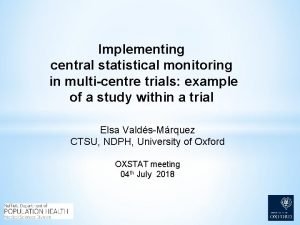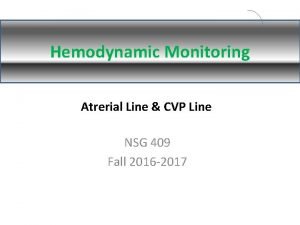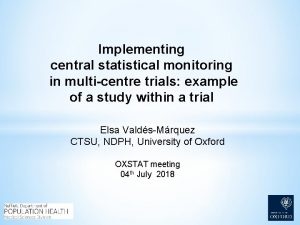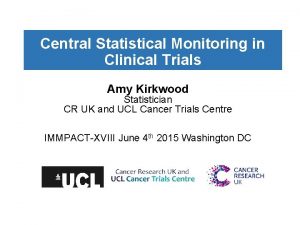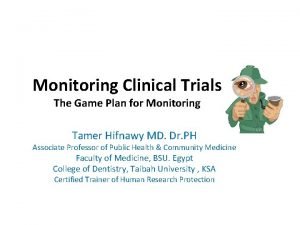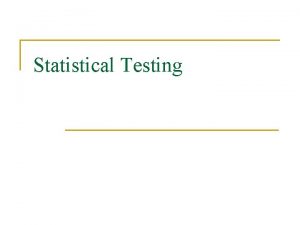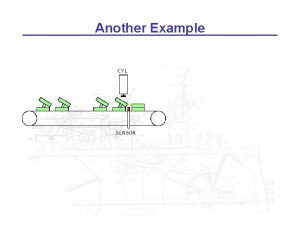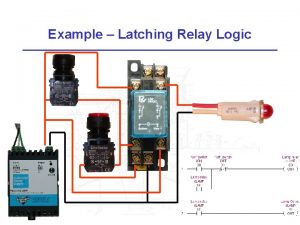Implementing central statistical monitoring in multicentre trials example





















- Slides: 21

Implementing central statistical monitoring in multi-centre trials: example of a study within a trial Elsa Valdés-Márquez CTSU, NDPH, University of Oxford OXSTAT meeting 04 th July 2018

Outline • Motivation and guidance for quality assurance • The role of central statistical monitoring in multicentre clinical trials • Initial key risk indicator approach • Advanced key risk indicator approach • Conclusions

Reliable evidence and monitoring Essential for appropriate decision making concerning the benefits and risk associated with clinical interventions. Monitoring is used in trial to identify errors in trial conduct. Monitoring can take different forms. For example, onsite monitoring and/or central statistical monitoring.

Type of data issues Buyse M. Applied Clinical Trials, 2014

On-site monitoring visits: Criticism • Largely retrospective: Too late to address any issues • Poorly focussed: Emphasis on checking individual data points & documents • Unsustainable: Inefficient and costly

Risk-Based Monitoring

Central statistical monitoring (CSM) can be used to detect data issues and unusual sites and thereby help to: • Prioritize sites visits (and additional training) • Generate actionable objectives throughout the trial • Ensure overall data quality

Approaches to central statistical monitoring • Hypothesis-driven/supervised: Small number of variables mostly likely to affect reliability/safety of the trial. Also, known as key risk indicators (KRIs). • Hypothesis-free/unsupervised: Large number of tests of all available variables in the dataset.

Approaches to central statistical monitoring • Hypothesis-driven/supervised: Small number of variables mostly likely to affect reliability/safety of the trial. Also, known as key risk indicators (KRIs). • Hypothesis-free/unsupervised: Large number of tests of all available variables in the dataset.

CSM in cardiovascular mega-trials • Large-scale multicentre cardiovascular trials (e. g. THRIVE, REVEAL) • Large number of sites across different countries • Systematic differences across countries (stratify analysis needed) • Typically 10 -200 participants per site • Long follow-up period • Electronic case report forms (e. CRF)

Initial KRI approach • Select KRIs relevant to the trial E. g. visit duration, serious adverse event (SAE) rates, compliances, etc. • Sites assessment per KRI: • Select a summary measure of interest For each site, calculate a summary measure such as mean, variance, proportion, rate. E. g. SAE rate. • Identify extreme sites Define a KRI specific critical threshold, giving sites passing this threshold a score of 1 (0 otherwise). E. g. give sites with a low SAE reporting rate relative to comparable sites a score of 1. • Sites classification: Create a summary score for each site based on the sum of the individual KRI score (weighting each KRI as appropriate)

Initial KRI approach • Select KRIs relevant to the trial E. g. visit duration, serious adverse event (SAE) rates, compliances, etc. • Sites assessment per KRI: • Select a summary measure of interest For each site, calculate a summary measure such as mean, variance, proportion, rate. E. g. SAE rate. • Identify extreme sites Define a KRI specific critical threshold, giving sites passing this threshold a score of 1 (0 otherwise). E. g. give sites with a low SAE reporting rate relative to comparable sites a score of 1. • Sites classification: Create a summary score for each site based on the sum of the individual KRI score (weighting each KRI as appropriate)

Initial KRI approach • Select KRIs relevant to the trial E. g. visit duration, serious adverse event (SAE) rates, compliances, etc. • Sites assessment per KRI: • Select a summary measure of interest For each site, calculate a summary measure such as mean, variance, proportion, rate. E. g. SAE rate. • Identify extreme sites Define a KRI specific critical threshold, giving sites passing this threshold a score of 1 (0 otherwise). E. g. give sites with a low SAE reporting rate relative to comparable sites a score of 1. • Sites classification: Create a summary score for each site based on the sum of the individual KRI score (weighting each KRI as appropriate)

Application in a multicentre trial Example of KRI: Under-reporting SAEs Thresholds depend on region Site A site deviates excessively from comparable sites if the SAE rate < predefined threshold

Application in a multicentre trial Example of summary score: A score based on the (weighted) sum of the individual KRI score Site 0. 50 0. 25 0 Scores for KRIs Noncompliance 0 0 0 1 1 1 0. 75 0. 50 0. 25 1 0 0 0. 50 0. 25 A 3 A 55 A 24 Visit Duration 1 0 1 B 139 B 163 B 134 C 206 C 199 C 193 ALT Summary score 0 1 0 Muscle Symptom 0. 83 1. 00 0 0. 33 0 1 1 0. 67 0. 86 3. 75 3. 50 3. 11 0 1 0. 86 1 0 0 0. 86 1. 00 3. 36 2. 11 SAE 2. 33 2. 25 2. 00 Individual KRIs weights account for their relative importance to the CSM process

Advantages and limitations of KRI approach • Easy to interpret • Tailored to each trial • Variable weighting is flexible • Criteria/scoring subjective • Size of sites is not considered

Progress in KRI approach Select KRIs relevant to trial Site assessment per KRI Create a summary measure of interest Identify extreme sites Sites classification

Progress in KRI approach Select KRIs relevant to trial Site assessment per KRI Create a summary measure of interest Identify extreme sites Sites classification Objective p-value to indicate how extreme a site is relative to comparable sites Based on a combined p-value across KRIs

Application in a multicentre trial On-site visit priority: Red: High; Orange: Medium; and Yellow: Low

Conclusions • Centre statistical monitoring helps to prioritize on-site visits; identify training areas, and ensure overall data quality in multicentre trials • We have developed a KRI approach for cardiovascular trials and on-site visits provided empirical validation. • General approach can be extended to other large trials; plans to release a R-packages will facilitate this.

Acknowledgements Jemma C Hopewell, PI On-site monitoring: Carol Knot CTSU trial teams: Martin Landray Louise Bowman Jane Armitage
 Central statistical monitoring
Central statistical monitoring Central statistical office trinidad
Central statistical office trinidad Map-cvp
Map-cvp Normal cvp
Normal cvp Intervention central behavior report card
Intervention central behavior report card Implementing hrd programs
Implementing hrd programs Implementing strategies management and operations issues
Implementing strategies management and operations issues Implement strategies management issues
Implement strategies management issues Chapter 7 strategic management
Chapter 7 strategic management Tripod pricing strategy
Tripod pricing strategy Implementing merchandise plans
Implementing merchandise plans Designing and implementing brand marketing programs
Designing and implementing brand marketing programs Designing and implementing brand architecture
Designing and implementing brand architecture Process oriented learning competencies
Process oriented learning competencies Crm project design and planning process
Crm project design and planning process Qsen competencies teamwork and collaboration
Qsen competencies teamwork and collaboration Challenges of implementing predictive analytics
Challenges of implementing predictive analytics Implementing organizational change spector
Implementing organizational change spector Implementing strategies marketing finance/accounting
Implementing strategies marketing finance/accounting Is the traditional method of implementing access control
Is the traditional method of implementing access control Checklist model for project selection
Checklist model for project selection Implementing strategies management and operations issues
Implementing strategies management and operations issues
